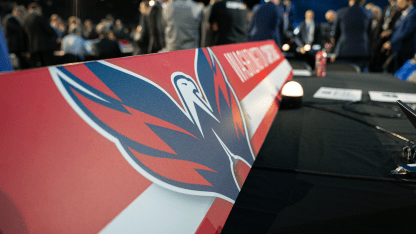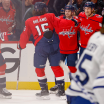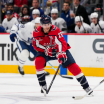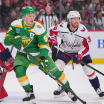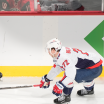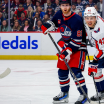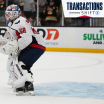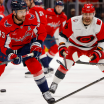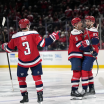It’s been only a few days since the thrilling conclusions of both the Stanley Cup and Calder Cup playoffs, and the NHL’s offseason is quickly and fully upon us. In Las Vegas, general managers, coaches, scouting staffs and other League and team personnel have descended upon the city in preparation for the 2024 NHL Draft on Friday and Saturday at Sphere in Vegas.
The salary cap shackles that have kept cap ceiling increases to a minimum over the last decade have given way to the most significant cap increase in years; the salary cap ceiling will climb to $88 million for the 2024-25 season. From its inception in 2005-06 through the 2014-15 season, the NHL’s salary cap ceiling climbed from $39 million to $69 million. But cap growth has been relatively flat since, climbing only to $83.5 million over the last nine seasons. The $4.5 million increase for the upcoming season is the largest since a $4.7 million bump from 2013-14 into the 2014-15 season.
That additional cap space has already manifested itself; at least a dozen deals have been consummated in the last 10 days, with the likelihood of several more on the horizon between now and the end of the weekend. And the end of the weekend will also usher in the opening of the NHL’s annual free agent frenzy, another entity that will benefit from the extra cap dollars that are suddenly bulging the wallets of the League’s 32 teams.
Recent history shows us that most of the roster building and construction for the upcoming campaign will take place in the next several weeks. Late July is typically quiet, as is August, and training camps open up in mid-September. Aside from the impending trades, free agency signings, buyouts, qualifying offers and arbitration hearings in the days ahead, summer development camps around the League will also be conducted in the next 10 days or so, and the League is also expected to release schedule for the upcoming season within the next week.
With all this activity humming in the overheated desert, and with the start of the 2024 NHL Draft just a day away, Caps president and general manager Brian MacLellan took some time Thursday to speak on these and other matters, and how he expects to proceed with his own roster shaping in the days and weeks ahead.
“There seems to be a lot of conversation,” says MacLellan. “I think the increase in the salary cap benefits the free agents that are coming in, so I think guys will probably be a little more aggressive in signing the free agents.”
By the time he arrived in Vegas last weekend, MacLellan had already engineered one of the most noteworthy offseason deals to this point, collaborating with fellow Bowling Green University alum Rob Blake, his GM counterpart in Los Angeles. The Caps dealt goaltender Darcy Kuemper to the Kings in exchange for center Pierre-Luc Dubois, who just turned 26, has seven seasons worth of NHL experience, and is under contract for the next seven seasons at an annual salary cap dent of $8.5 million.
“I think we’ve acquired a young player who has actually played [seven] years in the League,” says MacLellan. “He is a young player that is experienced. We got a player that we think we can get more out of consistently, and we’re excited to have him. We’re going to give him a good opportunity, a good role on the team. The coaching staff is excited, the players seem excited, so hopefully it’s a good fit going forward.”
MacLellan has kept working the phones here in Vegas, and as always, he is up front about what he is seeking.
“I’m looking at our defensive mix; I wouldn’t mind changing that up a little bit, and adding a forward, also,” said MacLellan early Thursday afternoon.
Hours after his Thursday media conference, MacLellan made another move to add a forward, sending a second-round pick in the 2025 NHL Draft – a pick originally belonging to Colorado – to Calgary for veteran winger Andrew Mangiapane. The 28-year-old Mangiapane has one year left on a deal that carries an annual salary cap hit of $5.8 million.
The Dubois deal leaves the Caps with Charlie Lindgren as the lone netminder on the team’s varsity depth chart, but both AHL Hershey goaltenders – Hunter Shepard and Clay Stevenson – had excellent seasons as the Bears claimed their second Calder Cup title in succession earlier in the week.
“We’re going to give those guys a shot,” says MacLellan of the two Hershey goaltenders. “We’re also going to look at if there is an improvement we can do through trade or free agency, too. All avenues are open for us on that. Charlie had a good year last year, and we’ll see how he handles the number one role in the beginning of the year, too.”
MacLellan is still poking around the rosters of the other 31 clubs for players who can help the Caps next season and beyond, and he also has some interest in this summer’s free agent class.
“I’d like to participate in both,” he says. “I think there is a couple free agents that we have a lot of interest in, and if we can work it out salary and term wise with those players, we’ll be aggressive in that. And then it would be nice to make a trade or two more, too.”
As the summer wears on, the Caps and veteran right wing T.J. Oshie continue to seek a “solution” that would enable the oft-injured warrior to play out the final season of his contract with more time in the lineup than out of it.
“He is working through it right now,” says MacLellan. “We’ve had a number of specialists talking with him; it’s probably the same as it was when I last talked to you. He is looking for a solution, and we’ll work it out as we go through the summer.”
The League’s annual free agent feeding frenzy gets underway at noon on Monday, but first the Caps will conduct their 2024 NHL Draft from Sphere in Vegas. Washington’s first choice is the 17th pick overall, and they believe they’ll be able to add another blue chip prospect with that selection. Washington has three third-round choices in the 2024 NHL Draft, and it has five picks in the top one hundred – picks 17, 52, 82, 83 and 90 – for the first time since 2008.
“I think it’s deepest on [defense]; the defensemen at the top seem to be pretty good players,” says MacLellan of the draft class of 2024. “Three is a section of players at the top that are really good, and then I think it’s going to be a little gray as you get closer to us. Teams will have guys they like better than other guys, so it might get mixed up a little bit as it approaches our pick.
“We’re excited. I think Ross has a few guys that he really has interest in, and we hope we can get one of them.”
“Ross” is Caps’ longtime assistant GM and draft operator Ross Mahoney, who will be conducting his 27th NHL Draft.
“There is a strategy that goes into it also,” says Mahoney. “You kind of have the first round spread into some layers, and when you’re picking at 17, if you targeted a couple of players that you felt might not be there when you’re picking at 17, then you might entertain the thought of trying to trade up a few spots in order to do that, to get one of those players.
“Or it could be the opposite, too, where maybe some of the players that you have in a certain layer are gone, and you’re going to trade back and acquire another pick later on it the draft. That’s all part of the strategy that goes into it. But in the first round, usually we’re taking the next player on our list, the best player available to us.”
With 13 picks in the top three rounds of the next three drafts, the Caps are poised to add more high-end prospects to the stable, but they’ll be seeking a balance with that accumulated draft capital.
“I think we’d like to do both,” says MacLellan. “We’d like to continue to draft young players; our amateur staff has done a great job over the last few years. And we’d also use some picks to acquire guys, or to improve our team. We are at a stage now where we can balance both picking and making trades using the picks.”
Hershey’s back-to-back championships are a real organizational highlight for the Capitals, and the consecutive successful playoff runs have been a plus in the development of some of Washington’s recent draftees. Hendrix Lapierre, the Caps’ first-round choice in the 2020 NHL Draft, led the AHL in playoff scoring and won the Jack A. Butterfield Trophy as the Calder Cup playoff MVP.
“I think it’s been huge,” says MacLellan of the Bears’ consecutive Cup crowns. “You look at Lapierre, who had [51] games in the NHL last year, played in the first round of the [Stanley Cup] playoffs against the Rangers, and then went down and won the MVP of the Calder Cup [playoffs]. That’s an impressive development path for him, so we’re excited about what happened with him.
“[Ivan] Miroshnichenko got better as the year went on; I thought he played really well in the playoffs. [Bogdan] Trineyev showed improvements, both our goalies have played well. I think just the experience of playing that hard of hockey, that competitive of hockey is going to be invaluable to all of our guys. And to have that success, and to share that success with their teammates, and hopefully they bring it up to the NHL level and it results in us having a better organization.”
A dozen Washington draft choices had a hand in at least one of those two Calder Cup titles, and some of those players have already matriculated to the NHL and are Capitals regulars.
“To win back-to-back Calder Cups is such a hard thing to accomplish,” says Mahoney. “It’s a real credit to the coaching staff, they’ve obviously done a good job and they have a tremendous chemistry, too, watching that staff. And [Bears’ VP of hockey operations] Bryan Helmer managing it. And then you get your development team of Steve Richmond, Jim Slater, Olie Kolzig and Brooks Orpik, and they played a big role in it. And the pro [scouting] staff, being able to get the good veteran players. And then obviously we have chipped in on the amateur side too, and you have the Lapierres and Trineyevs and Sutters and Miroshnichenkos, and [Vincent] Iorio and [Lucas] Johansen.
“But to win, I think anytime your players grow up in a winning environment, it’s just such a positive thing. I think it’s really easy to learn how to lose, and it’s really hard to learn how to win, and I think that really bodes well for the future for our young players.
“It is for sure, and I was so impressed with how we did last year in Spencer’s first year, coming in as a first-year coach and the job that he did. Obviously, we had some injuries, too, and he got a lot of those younger kids into the lineup. And we ended up making the playoffs, and I think playing in the NHL playoffs is a whole other animal. For the young guys who were able to play in that, it’s a really good experience and I think we’ll see them in the summer really working to get bigger and stronger, just because of that intensity and how it gets ramped up in the playoffs.”
It’s a busy, intense and fun time on the hockey calendar, and it’s a key moment in the transition of the Caps from the Alex Ovechkin era, to whatever lies ahead after the Great Eight’s sweater is hanging in the Capital One Arena rafters.
“I think it’s really good, and it’s a real testament to the pro [scouts] and the players that we’ve acquired,” says Mahoney. “You look at [Dylan] Strome and how well Strome played; he had a great year. And then we pick up Dubois, and we’ve got [Rasmus] Sandin, who we’ve picked up. And Brian has got these extra picks for us; we’ve got three thirds this year and three seconds next year [one of which was expended to acquire Andrew Mangiapane on Thursday].
“You can see a little bit of a transition on the fly, but we’re very, very competitive, too, which is a really, really hard thing to do. Some teams build their team up and then start over from scratch and there are some really lean years. Other teams are kind of older, older, older, and I look at us and I think we’re going to be a really good team again.”

